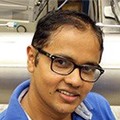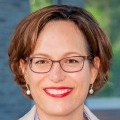“I have learned a lot through the course of my journey…I love what I do”
“I love taking on challenges and finding new solutions!” Betty Jean-Pierre laughed, comparing her role as an aviation administrator in the U.S. Navy to her role as an accelerator division staff administrator at Thomas Jefferson National Accelerator Facility, a U.S. Department of Energy national laboratory. At first, Jean-Pierre wasn’t quite sure what career she wanted to pursue when she joined the military – she just knew that she wanted to work in the Air Force or the Navy due to the rapid technological advances that were presented at the time.
Growing up in Brooklyn, New York, Jean-Pierre said that she was tired of the grind and knew that she wanted to see the world. After considering her options, she quickly became an aviation administrator in 2000, where she updated technical publications, managed libraries, prepared reports and correspondence, scheduled aircraft inspections, issued work orders, maintained engine logbooks and aircraft records, and supervised two sailors.
“Overall, I like to organize and figure out how to make things run more efficiently – working in administration allows me to do that. I love when I have the freedom to help turn clutter into order.”
Jean-Pierre said that her favorite part of serving in the military was that she was her own boss. She used her organizational skills to ensure that the day-to-day operations ran smoothly and always served as a helpful resource in case someone called on her. The diversity in surroundings allowed her to interact and communicate better and on a more professional level with others, improved her interpersonal skills. She also credits the military with honing in on the importance of paying attention to detail – something she depends on daily at the lab. Working in the military allowed her to sharpen her managerial skills, which eventually led her to complete her BA in Business Management in 2006.
“It’s so important to ensure the information you are sharing is accurate and succinct. Mistakes in the military can cost someone’s life,” she says. “At the lab, it could have similar impacts when it comes to reporting numbers and safety-related information. It is so important to me to relay detailed information correctly.”
Today, Jean-Pierre proudly mentions that one of her favorite parts of her current role is that she is a valued member of the team – and that her input is listened to.
“I am given the respect to give my perspective and my ideas of how things can improve, as well as share my opinion about pursuing possible next steps. I like being involved and I want it to stay that way because that’s where my management and leadership skills come in! I have learned a lot through the course of my journey leading into this role. I love what I do.”
Thank you for your service, Betty!
By Rebecca Anderson









































